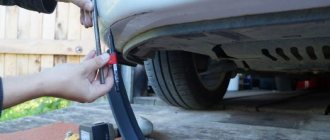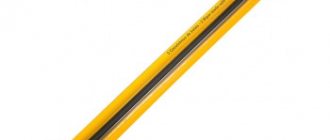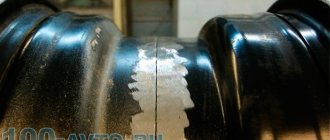Let's start replacing
The video shows how to change the front suspension silent blocks:
So, if you are determined to replace the silent blocks yourself, then in addition to the standard set of tools you also need to take a vice, a medium-sized sledgehammer, and extended bolts. Before you begin the process, decide which node you want to start with and see which elements have failed.
Also, let's immediately find out what not to do when replacing the silent blocks of the lever:
- Do not lubricate new silent blocks with engine oil. Remember that they are made of rubber, which quickly breaks down after contact with oil.
- Don't replace just one worn item. Replace all such parts on the axle at once.
- Do not burn the rubber with a soldering iron to remove the silent block. You won't achieve anything by doing this, you'll just inhale smoke.
- Do not remove multiple rods at the same time. This can make it very difficult to install them back.
Replacing the rear silent blocks includes installing the rear suspension arm and ball joint. To do this you will need a hydraulic press and a mandrel. However, if you take a risk, you can do without them.
First you need to remove the part. To do this, pull or clamp the rod in a vice. Take a long drill bit and drill holes in the rubber in a circle. The distance between holes should be minimal. Now you can easily pull out the inner bushing of the silent block. Try to make sure that only the outer ring remains.
In the video, the rear wishbone silent blocks are being replaced:
Now insert the hacksaw blade and make two cuts along the entire length of the remaining clip
Be careful not to cut through the rod. Use a chisel to hook the edge of the cut section and bend it inward using a hammer
Do the same on the other edge of the part. Remember, every blow of the hammer brings you closer to victory. At one point, the silent block clip will begin to creep down and you can easily knock it out.
You will also need time to return the silent block to its place. To do this, take two good metal pancakes that have a hole inside. The inner bushing of the silent block should easily fit into it.
Now place the rod on the floor, install the element, cover it with a pancake and hit this structure with a pancake. With a strong and accurate blow, it will partially go in. Be careful as it may bounce or become askew.
The video shows the installation of a polyurethane silent block:
If you managed to drive the silent block the first time, now you can put more force into the blow. Don't forget to put a second metal block under the rod, otherwise the bushing will rest against the floor. Now a couple more blows and the installation is complete, you can proceed to the next unit.
Replacing the front silent blocks is practically no different.
It is important to adjust the wheel alignment after the work has been completed. As you can see, to replace silent blocks you will need to put in a lot of physical effort and spend at least a day in the garage
Be attentive to the described nuances of this technological process, so as not to contact a service station later. If you are careful, persistent and patient, you will have new silent blocks, which means silent trips and serviceable car components
As you can see, to replace silent blocks you will need to put in a lot of physical effort and spend at least a day in the garage. Be attentive to the described nuances of this technological process, so as not to contact a service station later. If you are careful, persistent and patient, you will have new silent blocks, which means silent trips and serviceable car components.
Pressing out at home
Replacing these parts is not as difficult as it might seem at first glance. For example, many car owners made sure of this when they replaced parts, using special equipment for self-replacement. It is for this reason that there are many people who have decided to replace silent blocks with their own hands and at home.
First method
First of all, let's learn about how it should be ideally.
The lever in which the rubber-metal hinge needs to be replaced is installed on a special spacer for the press. The old silent will be squeezed onto this spacer. Then another spacer is installed on top - it squeezes out the old bushing. This method is used by service station workers, since they have the necessary set of spacers and a powerful press of 10-20 tons.
Second method
Almost all car owners, naturally, do not have a powerful press, but many have a jack or a good vice in their garage. If you use a powerful vice, you can successfully squeeze out the old bushings according to the principle that is already familiar to us: a spacer for the original bushing and a spacer for pressing on the bushing.
At first glance, it becomes unclear how you can squeeze out the silent tape with a jack? Everything is very simple: you need to weld a frame in the shape of a rectangle from a channel or corner so that its height is slightly higher than the lever and the jack. The operating principle is as follows: place the jack in the frame, then install the lever eye on top of the rod, as well as the two spacers mentioned above. We create the required pressure, after which the bushing is squeezed out of its seat. It must be emphasized that most often a jack with a capacity of 3-5 tons is not able to cope with such work, therefore it is recommended to use 10-ton jacks.
Third method
If you have neither a press nor a jack, but still have a strong desire to replace the silent blocks on your own, you can use the third method - using a simple press puller (bolt with nut or stud).
The principle of operation is to create pressure by gradually tightening the nut on the stud; this method can be called an analogue of a vice. This pin with a washer of suitable diameter is inserted into the eye through the silent block, then on the other side you should put on a spacer with a washer and tighten the nut. Rotating along the thread, the nut creates the necessary pressure and forces the silent to be squeezed into a special spacer.
What are silent blocks
Silent block is a part that dampens vibrations that occur between the suspension elements during movement. Thus, it dampens noise and vibrations that can lead to rapid wear of parts. The hinge is very important because it is responsible for the correct operation of the entire system. It consists of inner and outer metal bushings, with a rubber or polyurethane gasket placed between them.
Note that polyurethane silent blocks are considered more durable and last up to 2-3 times longer than rubber ones. Cars equipped with polyurethane hinges listen better to the driver.
It is important to monitor the serviceability of silent blocks, because their breakdown leads to difficulties in controlling the car, slowing down the reaction - the car will not immediately respond to the driver’s actions. In extreme cases, the car will wobble from side to side at speed.
Pressing in silent blocks
We have already talked in detail about how to get the “silents”, now another problem arises - how to press this part? This procedure is difficult because it requires certain skills and abilities. An incorrectly or crookedly installed silent will either not work or break prematurely.
First method
As with pressing, pressing should ideally be done using a vice. The principle is somewhat similar, but just the opposite. Before pressing the part, you need to thoroughly clean the seat from any residues and rust from the previous silent using sandpaper. Then the eye is generously lubricated with a lubricant like “Litol” or with a soap solution. A lever is installed, the part is placed on top, after which press pressure is applied to the spacer through a special mandrel. It will press the part into the seat.
Second method
When you do not have a press, you can press the part using the above-mentioned jack or a vice. The principle of operation is no different from a press. The lever, bushing, and spacer are installed. Then, under the force of a vice or jack, the part is pressed into the seat.
Third method
Press puller. If the silent block is small, you can “put it in its place” using the same press puller that was used to press the part out of the socket. Again, the principle is the same, only a thick washer and a pin are used as a press.
Fourth method
Using a sledgehammer and brute force. This method is not the best of all existing ones, since it is considered more from a purely theoretical point of view. In other words, it really allows you to press a part, but it’s very difficult to say what the results and quality of work will be. The principle is quite simple: we take a lever, put a silent on it, and then hit it quickly and hard.
After such a strong impact, it should go into the ear of the lever. Only the main drawback of the method is that it is not so easy to predict the correct movement of a given part; it can fit crookedly into the landing site. Among other things, “biting” of the rubber components may occur and damage to the lever itself or the silent block. Simply put, the blow is very difficult to control, and often after this kind of “experiment” you have to turn to specialists and redo everything again. Therefore, think carefully about the possible consequences before using this method.
Fifth method
The last known method of pressing a silent is to use the weight of the car. The principle is to use the weight of your car for personal gain. It all happens like this: install a hydraulic or screw-shaped jack and remove the wheel. Then install the lever with the silent, which needs to be pressed, under the hub.
Lessons from Audi
The Audi TT is one of the best small sports coupes in the world today.
There were no signs of trouble with the Audi TT sports coupe. The company is serious, the car passed all possible tests, was sent to people, but a few months after the start of sales, information began to appear about increasing cases of accidents involving TTs associated with a sudden loss of controllability at high speeds
With a sharp release of gas, in long turns, with any careless movement of the steering wheel, the TT completely lost the connection of the rear axle with the road. The number of accidents acquired catastrophic proportions, which forced engineers from Ingolstadt to conduct repeated, more detailed studies
It turned out that at speeds above 200 km/h, despite the intelligent control system for aerodynamic elements, the grip of the rear wheels with the road was almost completely lost, and when braking this was felt even more clearly. The company put their heads together, but the car was already firmly on the assembly line, so the solution had to be instant and effective. It was found. If we list the changes that Audi has made to the TT's design, it will seem like a joke to many, but the car's handling has stabilized, and the TT is one of the best small sports coupes in the world today. Here's what has changed.
The front stabilizer has become a millimeter thicker, the rear stabilizer has become a millimeter thinner, and most importantly, the geometry of the front arm has been microscopically changed and the diameter of the lower silent block has been increased, therefore, it has become a little softer. That's all that has been changed, but the car has excellent handling and stable, predictable behavior at any speed. Therefore, any change in the characteristics of the silent block can greatly affect the vehicle’s handling and, as a result, traffic safety.
What's happened
The silent block is a rubber-metal bushing, which is designed to connect two parts. An internal polyurethane insert connects two separate metal bushings and the whole thing is inserted into a metal cage.
This part dampens or reduces the force of impacts coming from the wheels onto car parts, thereby protecting them from premature failure. You can imagine the force of impact on the block when driving on uneven road surfaces. The silent block (“quiet block”) is used in the rear and front suspension, for mounting the engine, gearbox and other parts of the car.
Thus, it becomes clear that the “quiet unit” is very important for the car and its timely replacement will avoid more expensive repairs.
Silent block design and materials
The silent block is designed very simply. An outer bushing that is pressed into the suspension arm, an inner bushing that is bolted to the front beam or subframe, and they are held together by special rubber or polyurethane. The main task of the part is to provide a movable connection and dampen vibrations in the suspension, as well as adjust the angles of rotation of the front arm under high loads. For almost every car today you can buy both a rubber silent block and a polyurethane one. There is a difference, and not only the price of parts can affect the choice. It makes sense to take a closer look at both bushings so that replacing the silent blocks of the front levers can be done with great effect.
The silent block provides a movable connection and dampens vibrations in the suspension
Polyurethane appeared in modern cars not so long ago, and it was used mainly on sports cars. A little later, the counters began to be full of multi-colored polyurethane silent blocks, but compared to rubber ones, their price was almost three times higher. The calculation was, of course, not for the owners of the VAZ 2109 or 2110. At that time, they were quite satisfied with ordinary bushings made of oil- and petrol-resistant rubber. But owners of used Renault, Mitsubishi Pajero or Nissan Patrol will think twice before ordering a branded silent block for a fairly substantial amount, so polyurethane parts have begun to be popular with them.
How to press in a silent block
The silent block enters the lever with force. Therefore, simply inserting it into place will not work. You need either a special press, which is used at service stations, or some simple tools that craftsmen use to press in silent blocks (see video).
There are several “folk” methods. But their meaning is the same: first you need to remove the old silent block, clean the seat on the lever, and press in a new one. There are usually no problems with removing rubber, but removing the outer race (shell) can be difficult.
Before pressing in the silent block, you need to remove the old one.
An alternative is to make a neat cut with a jigsaw (do not touch the lever itself), and then use a hammer and some metal object to knock out the sawn clip. Don’t rush to throw it away - you may need it when pressing.
Then the seat must be thoroughly cleaned, all burrs and sharp edges removed. The surface should be flat and smooth. Then, if the silent block does not have an external metal frame, lubricate it and the seat to facilitate the process. There are two options: use soap (soap solution), silicone grease (suitable for silent blocks made of polyurethane) or lithium-based grease (with an iron cage).
How to press in a silent block
Next comes the process itself. Some people use a vice and a sledgehammer, others only a vice. The simplest option is to center the bushing relative to the seat and use a sledgehammer to drive it into place. But this method requires some skill. In the absence of experience, it is easy to damage not only the silent block, but also the part into which it must be inserted.
A slightly more complicated option: secure the lever in a vice, center the new bushing, place an old metal clip on top of it, and on top of it some kind of device that can be hit with a sledgehammer or hammer. We center all this and begin to drive the bushing into place with a sledgehammer.
Instead of hitting with a sledgehammer, you can use the force of a vice. Then place the entire structure in a horizontal plane and press it with a vice. Firmly holding the lever or other part into which you press the silent block, clamp the vice until the bushing is in place.
How to press a silent block into a lever
Here are several ways to press in a silent block. Whichever one you like best, use it.
Separately, we need to talk about how to press the silent block into the shock absorber.
Before pressing the silent block into the shock absorber, you need to remove (knock out or squeeze out) the old silent block
You will most likely have to remove the old one in parts - first drill out the rubber or squeeze it out (if you have something). Then carefully file the outer ring with a hacksaw blade and knock it out with a hammer (be careful not to damage the edges of the seat).
How to press a silent block into a shock absorber
Then, after inserting the appropriate block and finding the appropriate socket, hammer the bushing into place.
How to press a silent block into a shock absorber
Regulations for replacing silent blocks
On modern passenger cars VAZ Niva, Hyundai Accent, Chevrolet Aveo, Cruz, Dacia Logan, Daewoo Lanos and similar budget cars, the recommended schedule for replacing the silent block revolves around the figure of 100 thousand. There is no certainty on this issue, since polyurethane from a good company can cost at least 350 thousand, and an average lousy rubber silent block can crumble after 60 thousand, so you should always listen to their behavior, especially when the car was recently purchased or someone else’s.
In modern cars, the silent block needs to be changed once every 100 thousand km
The condition of the silent block can be assessed both visually and by the gaps or lack thereof. For a visual assessment, it is enough to inspect the levers, and if there are no delaminations, swelling, or chipping on the surface of the silent blocks, it is still normal. Knocking and play in the front suspension will also tell a lot. If replacement is still necessary, then it is quite possible to do it yourself, without involving service specialists. This will require mostly persistence and a philosophical approach.











